Prof. em. Dr. Jürgen Zimmer
A LITTLE DIARY FROM THE SCHOOL FOR LIFE –
PART II
26th July to 13th August 2012
Hanseatic School for Life, 26th July
A conversation with Sommart Krawkeo. As educational manager, he wants to bring the concept of the Hanseatic (formerly Beluga) School for Life to the far reaches of the coast which was ravaged by the tsunami in late 2004. Since August 2011, when the turbulence surrounding the collapse of the Beluga Group in Bremen slowly subsided and it became clear that the Beluga School for Life could survive with new sponsors and under the name of the Hanseatic School for Life, I have been acting in an advisory capacity for the project which I founded in 2005 after the tsunami and for which I acted as educational leader until 2010. My role is a voluntary one, for which the School for Life receives an annual compensation of €20,000 until my contract ends in July 2014.
Among other things, Sommart and I discuss a problem which is evident not only in Thailand after the tsunami, but also further afield – the fact that humanitarian aid projects, especially those of a prolonged duration, must be careful to ensure that people do not become dependent on external aid. Entrepreneurship education and social entrepreneurship, the approaches of the Schools for Life, represent good methods for preventing this tendency, instead teaching the children to stand on their own feet.
Thalang, 28th July
- First stop: Bremen: I am here on a visit, and go for a stroll through the town. I come across a shop which repairs shoes, copies keys and sells a few watches. I have owned a Swiss watch for the past twenty years, not an expensive one, but reliable – but now the glass cover has got a crack in it and the battery has given up the ghost. I ask the man behind the counter to replace the battery and the glass cover. He manages to open the paneling on the back of the watch, but is unable to close it again. After half an hour of concerted effort, he gives up, and I take back the glass cover, the watch, and the panel, I am about to pay for the battery, but the man says that this is against his code of honor, which find very friendly of him.
- Second stop: Berlin: With the components of my watch in my bag, I head for Berlin’s finest department store and find the section for fancy Swiss watches. I show them the individual pieces and tell them what I would like: a new glass cover and the paneling put back on. I am requested to come back in an hour. When I return, the expert behind the counter tells me with a dour face that the watch will have to be sent back to the manufacturer. They will contact me if the repair will cost over €200. Gulp!
After quite some time, I receive a message to say that I can come and pick the watch up. Back at the counter of this distinguished establishment, I am told that the watch is irreparable. I am somehow relieved – better the components of a watch than a dizzyingly extortionate bill for a glass cover and a panel which has been screwed back on.
- Third stop: Thalang/Thailand: This is a place that you really only drive through if you are going from the mainland of the coast province Phang Nga to the town of Phuket on the island of the same name, via the long Sarasin Bridge. In Thalang there is a covered market selling all kinds of paraphernalia, and not far from the entrance sits an old watchmaker at a little table. I give him the parts of my watch and ask whether he can help me. He nods. I sit down on a stool opposite him and wait, expecting him to give up. First he checks the battery, and says it’s new. Then he holds up a magnifying glass to his eye and barely five minutes pass before he has replaced the glass cover, having bent the minute hand back into place (it was a little bit crooked), screwed the cover back on and attached a sealing ring. He then turns around and reaches for a little polishing machine to give the watch a glossy finish. I ask the price, and he says 280 baht – which is about €7.36.
Vivat Thalang! Long live this watchmaker! And if our Swiss friends don’t shift up a few gears in their watch repair service, and indeed their price-performance ratio – whether it’s up to incompetence, arrogance, indifference, laziness, or urging people on to consume? – then at some point they will find out that you don’t always rise in the market, but can also fall.
Chiang Mai, 6th August
Ott, who went from ‘Bad Boy’ to polo player, has returned from Argentina. While he was there, he was trained as an up-and-coming professional. Ott is overwhelmed. He learned more there than he had learned in the rest of his life put together. He has now understood what it means to learn, and wants to learn about everything – religion, philosophy, politics – he has a multitude of questions that want answers. Dominique Leutwiler is the right person; she listens and answers with great patience. After a few days’ holiday in Chiang Mai, Ott is back at the Pattaya Polo Club and it’s onwards and upwards.
The owner of the club, Harald Link, has donated the school three beautiful horses and commissioned some stables to be built in a traditional style on some land on Lamphun Road in Chiang Mai. Now the way has been paved for offering equine therapy. There will be no lack of demand.
Chiang Rai, 7th August
A mother and father belonging to the Karen people tell me that their daughter, who goes to school in the border town of Chiang Rai, has been reprimanded by her teacher for dying her hair brown, which is forbidden. She hasn’t though – her hair is naturally brown, like her mother’s – yes, there are brown-haired people in Thailand too. The teacher, however, doesn’t believe this and has continued to scolds her. So the daughter now dyes her hair black every morning so that it looks as if it hasn’t been dyed.
School for Life, 8th August
On the lower part of the campus, the area which is being used for organic farming is increasing. Chanmongkol, the manager of the Center of Organic Farming & Animal Husbandry, accompanies me around the grounds. Down at the creek, tightly-woven bamboo boxes lie in the water protruding by about 30cm, and teeming with fish. I ask whether the especially agile fish are still jumping over the edge of the baskets on a bid for freedom. Well yes, replies Chanmongkol, but there are also immigrant fish that jump in when the fish inside are fed, eager to join the meal. All told, with emigrants and immigrants, numbers remain more or less stable.
On the field below the sports facilities, all manner of vegetables are growing, including beans and cucumbers. At the start, Chanmongkol had been wondering where they were all disappearing to, until he noticed that the children were eating them straight from the field. He toyed with the idea of putting up a fence, but decided against it – the children’s bellies is where the food is intended for anyway.
Half a dozen piglets are grunting in the spacious pigsty. A big, fat pig holds its mouth open wide because Suchart the farm worker is spraying him with a hosepipe and the happy pig can shower and drink at the same time. We carry on, and call in at Suchart’s hut. I want to see something there that I have never seen before: Suchart is rearing three large geckos that will grow to be much larger still – about 40cm long and weighing 400 grams. Chanmongkol explains that they can then be exported to Arab countries and sold for 200,000 baht (€5260) each. Apparently, a medically coveted serum would then be extracted from them, from one point on their head and one on their tail. This is not (yet) a project which involves the children – rather an expression of Chanmongkol and Suchart’s desire to experiment. They assure me that they have heard about these dream prices from reliable sources.
I can see three geckos of half an arm’s length each, who have nothing to do in their separate, barred boxes than to flick their long tongues at the live grasshoppers which they are fed every evening. Chanmongkol and Suchart get the grasshoppers from Kru Tomsri, the teacher who – as well as having a lovely vegetable garden – keeps a whole menagerie of animals including a rat. The rat likes to eat grasshoppers, so these are being bred carefully and expertly in Kru Tomsri’s little queendom.
Namsom, whose mother was sentenced to imprisonment in the women’s prison in Chiang Mai for 25 years, also has a pet rat. It has become vegetarian because it is only fed vegetables. Namsom loves the rat, so it’s allowed to go everywhere and join in with everything. Namsom’s new family teacher finds this rather unhygienic, so the question arises of how to accommodate the rat appropriately. Namsom would probably enjoy the blockbuster animation film “Ratatouille”, a humorous call for a better status for rats in the animal class struggle; she hasn’t had a chance to see it yet though.
While the feeding up of the geckos is still in its early stages (the two breeders give me the reassuring information that geckos are neither a protected species nor subject to a ban on exports), another more advanced experiment is running in a dimly lit room adjacent to the auditorium. This has been conceived of by Khun Anchana, who works at the School for Life to guarantee thorough and transparent financial management, and has sought advice for this experiment from scientists at a university in Bangkok.
A small team of children and teachers show me the room in which silk worms are being bred. On a table are the cocoons from which the silk worms have now emerged as butterflies. In a corner behind this is a box, the open sides of which reveal a number of little hanging threads on which the butterflies have laid eggs. Having eaten their fill of mulberry leaves when they were caterpillars, the butterflies then live on a diet for the seven short days of their life, with time only to mate, ensure the existence of their offspring, flutter around the room and then die. A very short flight on the wings of love. As I watch these dark, large-winged beings, I think of opening the door and letting them escape to freedom, but am reminded that I wouldn’t be doing them a favor because it would make it difficult for them to find a partner and they wouldn’t be able to produce the next generation. Better then to leave them to their short moment of happiness in the little room.
School for Life, 9th August
The first installment of €20,000, paid by the Hanseatic School for Life gGmbH in Hamburg, is on its way. This money is desperately needed because the subsidies from Germany have decreased. Lots of sponsors have remained loyal for many years, but quite a few of them have now retired from professional life, and living on a pension, have to budget their limited resources.
The internationally experienced manager Maik Fuellmann has taken on the problem, and hand in hand with representatives of a major insurance company has thought up a way of motivating many customers to support the School for Life with small monthly sums of 6, 12 or 15 Euros. We are optimistic, and hope that this will be a success story.
In Germany, the team that looks after the School for Life has been reinforced: Andreas Dernbach, who was in development work for many years in Vietnam, has taken over the baton from Rita Haberkorn to become the new director of the School for Life Institute at the International Academy (INA), Free University of Berlin. Other members of the institute include Christian Luther, director of the Digital Print Centre ‘Laserline’ in Berlin, who will be responsible for setting up a support group, especially made of businesses; Dr. Julian Bomert of the Berlin University for Further Education, which – along with the Robinsohn Foundation – takes care of the collection, management and forwarding of donations and advises the School for Life; Ulrich Griesdorn, from the German Foundation Center, a longtime adviser and supporter of the project; Dr. Berndt Tausch, CEO of the Step Foundation in Freiburg, which has promoted physical education at the School for Life for many years; and Rita Haberkorn, whose commitment from the beginning of the project helped secure its existence and whose advice is still in demand. Dorothea Schrimpe and Kathrin Ebel have founded UMIWI together, selling beautiful colored glazed bangles made from mango wood, produced in Chiang Mai under the supervision of Dominique Leutwiler – the proceeds go to the School for Life. Dr. Diethelm Krull has also joined the team, under contract from Barbara Hunz Personnel Management Ltd., and has taken on the task of fund-raising for the School for Life.
Of all institutions, the Shaul and Hilde Robinsohn Foundation is our oldest and most loyal supporter and competence companion, with their board members Prof. Dr. Götz Doyé, Rita Haberkorn, Dr. Gerd Harms, Dr. Hans-Henning Pistor and Dr. Wolfgang Schirp. The commitment of these people as well as the many others in Germany and Thailand is very moving, and I am very, very grateful to them all.
School for Life, 10th August
The publishing company ‘verlag das netz’ has sent a proposal for the cover of my book, “Semi-Controlled Chaos – 50 Years of Reports, Essays and Portraits”, which will appear in Autumn 2012. 600 pages of text, lots of illustrations and a title that is borrowed from a text by Herman Melville. In “Israel Potter – His 50 Years in Exile”, he writes:
“The career of a stubborn adventurer is obvious proof of the principle that those who desire success in the bigger picture should not wait for smooth seas – which have never existed and will never do – but rather begin making their way blindly towards their goal with the random methods they have to hand and leave the rest to fortune. For all human relationships are messy by nature, as they both stem from and are maintained by a kind of semi-contained chaos.”
The printing of the book will receive substantial financial support from Laserline and the publishing company, and both the profits and my author’s fee will be used to benefit the children at the School for Life.
In the early 1960s, I began writing a lot for the newspaper ‘Die Zeit’ in Hamburg, and later also for other newspapers and magazines, and found that curiosity about the immediate and wider world can lead to getting entangled in situations of semi-controlled chaos – and that it can be important to keep the goal in mind and to develop good ideas along the way. I have encouraged my students to approach different realities from different perspectives and to choose a lively language for their description rather than fall to the assumption that abstract jargon is necessarily enlightening. I remember a story told to me by ethnopsychoanalyst Mario Erdheim, who once visited a colleague in a remote part of the world – perhaps Borneo? – and was fascinated by the stories he heard in the evening by the fire. His colleague then presented him with an article as a farewell present, said to contain the stories he had told his friend, so that Erdheim could read everything again on his flight home. When he did, however, it was unrecognizable. All the vibrancy and color had fallen victim to icy sheets of technical jargon.
Our condition is part of the process of realization, as indicated years ago by a doctoral student who wrote her research about the Pinochet regime in Chile and the transmission of the traumatic experiences of torture victims to the next generation. She wrote down her fears, doubts and unanswered questions in a research journal, which added a second complementary level of commentary to the actual research process. The “semi-controlled chaos” can be conceived of as a biography – translated into camera movements – of my curiosity about the world, the risks that are taken and the attempts to capture and hold on to threads of a real utopia.
School for Life, 11th August
In Thailand, Mother’s Day is on the Queen’s birthday. At 9am, we gather outside near the entrance gate, in front of her picture. The headmistress, Siriporn, reads out a list of good intentions with her face turned to the royal image. This is done by all of the head teachers of all the schools in Thailand.
Today, the children are wearing what in this country is called “national dress” – the costumes of the Lisu, Lahu, Akha, Hmong, Karen, Thaiyai and the Thais of the North. A colorful picture. Celebrating Mother’s Day with children who often have no mother, either because she is no longer alive, or is not in a position to take care of her child, is a difficult and sometimes tearful affair.
I tell the children the story of the chalk circle: many, many years ago, two women both claimed that they were the mother of the same child. They quarreled violently and finally, went to court. Only one of them could be the real mother. The judge listened to both women, and then said he didn’t know who was the right or the wrong mother, and then he drew a big circle on the ground in chalk. He placed the child in the middle of the circle and ordered the two women to pull the child until one of them succeeds in pulling the child out of the circle – this mother would be the winner. The women began to pull, but then one of them let go. The other woman was triumphant, thinking the child was now hers. However, the judge took the child away from her and gave it to the woman who had let go, with the words: “You are the real mother, because you couldn’t bear your child to suffer.”
While I tell the story, which has spread since ancient times in different variations throughout various cultures, two young women who have come with a group of twelve from Kolping to do a work camp at the School for Life, play the roles of the two mothers. They take a kid and pretend to pull with all their might. Then one of them lets go. Now in the role of the judge, when I take the child away from the woman who held on and give the child to the real mother, this makes a big impression on the children, and some of them come running up to me and hang on me like grapes.
Later that morning, as every year on Mother’s Day, an Abbot comes with his monks and neighbors who live near his temple. They bring the children’s favorite food, and the Abbot shows them that Mother’s Day can be a good day even without mothers.
School for Life, 12. August
A few days ago, lightning struck the school. Nothing bad happened – no fire, and no one was hurt. The flash just broke the TV, DVD player and computer system. It will take a while until they’re repaired. I use this as an opportunity to spend the evening reading KurtTucholsky, volume 7 of his collected works. Tucholsky in 1929 on Bert Brecht, the copyist; Tucholsky on the Ten Commandments, which he no longer remembers; Tucholsky’s leaflet for jurors.
A few days after the lightning struck in the evening there is another storm. Now there is a power cut for hours. By candlelight, without music or film, it’s almost like being back in Wasserburg on Lake Constance in 1945, when we lived in a small, 15 square meter shack without power and water. We could hear the wind and the waves on the nearby lake. And I learned to pick up the cigarette butts dropped by the occupying forces and store them in matchboxes, exchanging them with the former German soldiers for a piece of bread or a corncob.



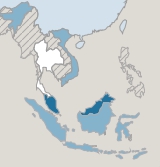
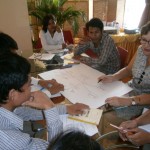
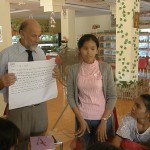
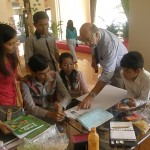
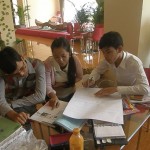
 Ellen Cornish is a very experienced Early Childhood and Primary School teacher from Hobart, Tasmania, Australia.
Ellen Cornish is a very experienced Early Childhood and Primary School teacher from Hobart, Tasmania, Australia. Dr Don Jordan had an extensive career in Tasmanian schools and completed his doctorate at Curtin University in Western Australia. Both Don and Ellen have had experience in other countries, either as visiting teachers or consultants. They have contributed several articles to SCLT.
Dr Don Jordan had an extensive career in Tasmanian schools and completed his doctorate at Curtin University in Western Australia. Both Don and Ellen have had experience in other countries, either as visiting teachers or consultants. They have contributed several articles to SCLT.